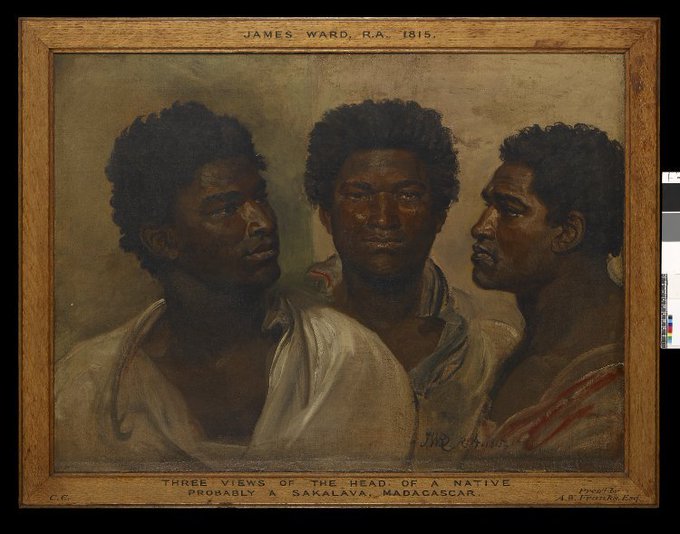James Ward also painted portraits, some conventional, other’s more unusual. Below, "Portrait of Edward Morgan, a Welsh labourer, aged 92" and "Three views of the head of a native probably a Sakalava, Madagascar" (both British Museum) 14/14
Three more landscapes by James Ward, born OTD in 1769: Stonehenge (1845, Birmingham Museums); Reculver Church, Isle of Thanet (1818, Canterbury Museums), and Kenilworth Castle (1840, Yale Center for British Art). 13/14
But James Ward didn’t just paint farm-yard animals and horses. Left: Brown long-eared bat (watercolour, Yale Center for British Art) Right: Double Portrait of Henrietta Ward's Pet Guinea Pig (1843, Lowewood Museum) 10/14
James Ward, born OTD in 1769, was an admired painter of animals. Around 1800 the Board of Agriculture commissioned him to paint a series documenting breeds of British livestock. "Two Extraordinary Oxen" (1814, National Museum Wales); Gloucestershire Old Spot (1800-1805, YCBA)9/14
Some parts of the building survived the fire, including Westminster Hall, the Undercroft Chapel and the Cloisters of St Stephen's. These were incorporated into the new Palace of Westminster, designed by Charles Barry and Augustus Pugin, and built between 1839 and 1870. 3/3
Hogarth: Place and Progress @SoaneMuseum - like meeting up with some old friends. A Rake’s Progress (1734), Four Times of Day (1736-7), The Humours of an Election (1754-5). Exhibition brings all his series paintings and engravings together for the first time. #HogarthExhibition
Self-obsessed, restless, antagonistic, exploitative - but he created some brilliant paintings. Gauguin: Portraits at the National Gallery.
There’s a lot of naked male flesh on display. In this one, for example, the heroic youth wearing nothing but a skirt of maple leaves is presumably a representation of Canada. India and Africa are marginalised: the latter represented by a small black boy carrying a fruit bowl.4/6
#LondonOpenHouse, an opportunity to visit the Foreign & Commonwealth Office to see, among other things, Sigismund Goetze’s murals on the Grand Staircase. Nationalistic allegories, they represent “the origin, education, development, expansion and triumph of the British Empire”1/6
And the sky was rent asunder and the Ancient of Days reached down and handed me an audio guide. Press preview of William Blake at Tate Britain. The exhibition brings Blake down to earth, but his weird and wonderful images remain as mysterious as ever. #WilliamBlake





























